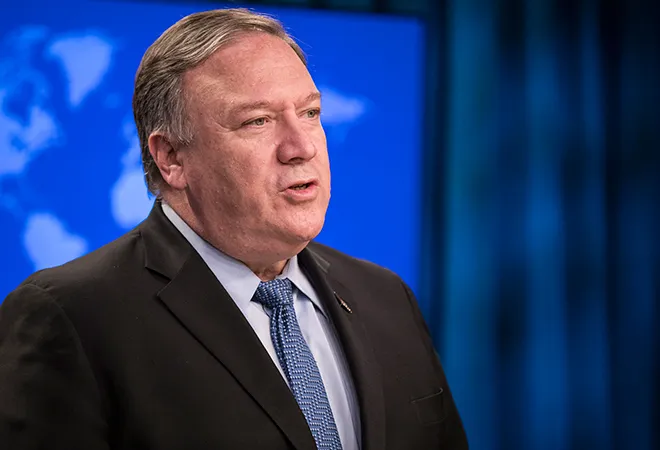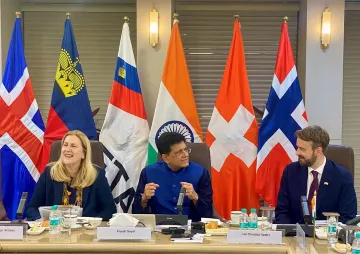
This week’s visit of US Secretary of State Mike Pompeo to New Delhi comes amidst a mix of convergences and divergences in the US-India bilateral dynamic. Even as US interests clash with India’s on issues like arms acquisition from Russia and energy imports from Iran; US and India are moving forward with strategic developments like the transfer of armed Sea Guardian drones. India’s strategic alignment with the US, signifies New Delhi’s willingness to share the onus of continuing the cultivation of strategic ties despite irritants on other fronts.
On the trade front, issues like the US’ revocation of India’s designation as a ‘beneficiary developing country’ under its Generalised System of Preferences (GSP) program bear near-term economic costs. In 2017, India was its largest beneficiary with exports to the US worth $5.7 billion, also enjoying duty free access. On the US’ revocation, India retaliated by raising tariffs on 28 US products.
In New Delhi however, Secretary Pompeo will likely temper tensions on such issues by underplaying them as ongoing discussions, and elevate conversations on strategic potentialities.
Fundamental divergences or Trumpian aberration?
The US’ revocation of India’s GSP benefits stems from its attempt to coax India to rethink its approach to ongoing trade negotiations — now in its second year much to the US trade negotiators’ frustration, on some of the long-standing fundamental issues in US-India trade. Earlier this month, Secretary Pompeo announced that on the GSP decision, the US is “open to dialogue” and most importantly “honest about what it is we’re trying to accomplish. We’re trying to take down barriers – financial barriers, non-tariff barriers – and create open markets.”
However, trade talks have been stalled, as India has approached the same as a matter of Trumpian aberration on fixating over ‘US’ trade deficits.
Whereas, US negotiators have viewed them from a standpoint of what they view as long-standing issues in bilateral trade, such as market access for dairy products and price caps on medical equipment. During his visit, although Secretary Pompeo would likely continue to stress on the fundamental divergence in either parties, approach to trade negotiations and avenues for US-India strategic ties will assume centre-stage given their monetary volume and long-term significance.
Embracing the strategic silver-lining
In recent years, strategic ties have assumed the fore of the evolving US-India dynamic. The Trump administration’s follow-through on the US Congress’ prescription to accord India with the status of ‘Major Defence Partner’ and Strategic Trade Authorisation-I, has opened greater avenues for US -India strategic cooperation.
Ahead of Pompeo’s visit, the US and India have already lined up defence deals worth around $10 billion. The same would encompass, India’s acquisition of 10 Poseidon-8I long-range maritime patrol aircraft, 30 armed Sea Guardian drones, 24 naval multi-role MH-60 Romeo helicopters, and the National Advanced Surface to Air Missile System-II. Lastly, the US and India are reportedly also in talks to sign the Basic Exchange and Cooperation Agreement for Geo-spatial Cooperation –– last of the three force inter-operability agreements.
The push by Secretary Pompeo for New Delhi to underline such strategic potentialities would also pertain to setting the stage for President Trump’s upcoming meeting with Prime Minister Narendra Modi on the sidelines of the G20 summit. This year, for Trump, the G20 summit is also going to be particularly crucial for his domestic political standing.
Road to 2020 passes through G20
This month, President Trump announced his re-election bid for the 2020 US presidential elections. On his flailing foreign policy record, Trump has accused Democrats of obstructing the ratification of successful trade renegotiations like his administration’s flagship United States-Mexico-Canada Agreement (USMCA) replacing the North American Free Trade Agreement (NAFTA).
Across the aisle, Democratic candidates have also referenced US-China trade tensions as a sign of Trump’s failings on the foreign policy front. With some candidates like Pete Buttigieg already outlining their worldview with the customary foreign policy speech otherwise meant to be delivered at a later stage of the primaries, the efficacy of Trump’s transactional approach to American international relations is emerging as a major election talking-point. Add to the mix: the first round of the Democratic primary debates will be held on the eve of the G20 summit in Osaka, Japan.
Apart from all eyes being on Trump’s highly anticipated bilateral with Chinese President Xi Jinping on the sidelines of the G20 summit, Trump is reportedly also set to hold seven other sit-downs with Russia’s Vladimir Putin, Saudi Arabia’s Mohammed bin Salman, and Turkey’s Tayyip Erdogan. These three meetings are sure to ruffle feathers back home given the US’ charged domestic polarisation over possible Russian interference in the 2020 elections, the killing of Saudi journalist Jamal Khashoggi, and Turkey’s exclusion from the F-35 development program. All this leaves Trump with four other bilateral meetings to score some foreign policy wins, or at least the appearance of wins through photo-ops and light-hearted moments. With Angela Merkel, Trump’s relationship has taken another turn for the worse, with his recent threat to move “as many as 2,000 US troops from Germany to Poland” over Germany’s inadequate defense spending.
Rest of the meetings are with leaders from the Indo-Pacific region — India’s Narendra Modi, Australia’s Scott Morrison, and Japan’s Shinzo Abe. In light of recent flare-ups in the Persian Gulf, questions have been raised over the US’ strategic shift to the Indo-Pacific. The meetings with fellow Quad members Modi, Morrison, and Abe would assume renewed relevance as an opportunity for Trump to reiterate US’ Indo-Pacific focus away from the turbulences of the Middle East. Moreover, in the particular case of India, the upcoming rounds of the US-India 2+2 consultative platform between foreign and defense portfolio chiefs, and the India-US Strategic Energy Partnership working groups between India’s Petroleum Minister and US Energy Secretary, would provide for better opportunities –– away from the galore of meetings between the heads of state, to iron out differences over India’s arms acquisition and energy imports policy.
Hence, in New Delhi, Secretary Pompeo will likely brush aside some of the recent contentions in bilateral ties, and elevate the conversation on upcoming avenues of strategic cooperation. As a result of which, at the Modi-Trump meet on the sidelines of the G20 summit, the uneasiness over the former will stand eclipsed by the emphatic hugs and laughs over the latter.
The views expressed above belong to the author(s). ORF research and analyses now available on Telegram! Click here to access our curated content — blogs, longforms and interviews.




 PREV
PREV


